The Nanotechnology Packaging Market is estimated to be valued at USD 23.8 billion in 2025 and is projected to reach USD 120.4 billion by 2035, registering a compound annual growth rate (CAGR) of 17.6% over the forecast period.
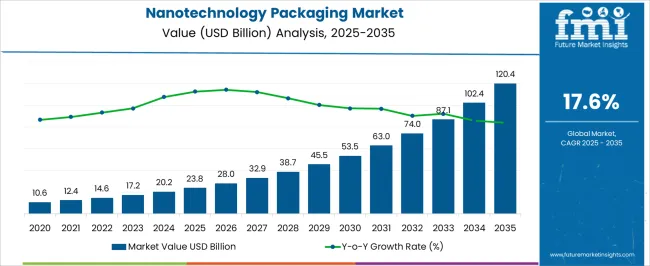
| Metric | Value |
|---|---|
| Nanotechnology Packaging Market Estimated Value in (2025 E) | USD 23.8 billion |
| Nanotechnology Packaging Market Forecast Value in (2035 F) | USD 120.4 billion |
| Forecast CAGR (2025 to 2035) | 17.6% |
The nanotechnology packaging market is gaining momentum due to the rising focus on food safety, product shelf life extension, and sustainable material innovation. Growing consumer awareness of freshness, authenticity, and contamination prevention is driving the adoption of nano-enabled packaging.
Technological advances in nanomaterials are enhancing barrier properties, antimicrobial resistance, and active interaction with packed goods, making them highly attractive to food producers and retailers. Additionally, regulatory emphasis on safe packaging standards and industry initiatives to reduce waste are supporting broader acceptance.
The market outlook remains promising as innovations in intelligent packaging, lightweight designs, and recyclable nanomaterials align with evolving consumer expectations and environmental mandates.
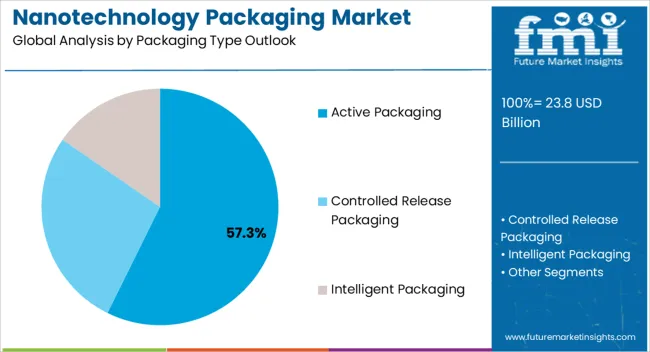
The active packaging segment is projected to hold 57.30% of the overall market by 2025 within the packaging type category, making it the leading segment. Growth in this segment is supported by its ability to enhance shelf life, prevent spoilage, and maintain product quality through oxygen scavengers, antimicrobial layers, and moisture regulators.
Manufacturers are adopting active packaging to meet rising consumer demand for safer and longer lasting food products while ensuring compliance with stringent safety standards. Its capability to reduce food waste and support sustainable supply chain practices has reinforced its market leadership.
Continuous advancements in nanocoatings and functional films are expected to further strengthen its application scope across industries.
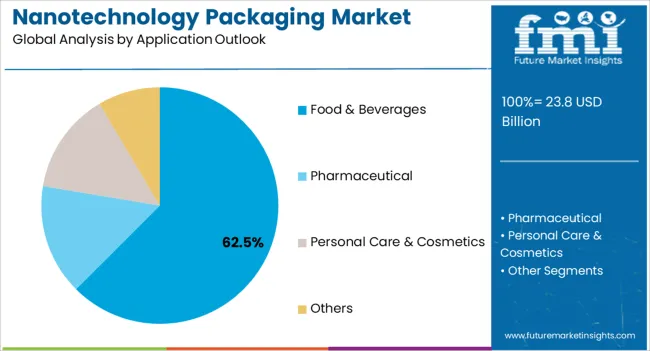
The food and beverages application segment is anticipated to account for 62.50% of total revenue by 2025, positioning it as the dominant application area. This is attributed to the critical importance of food preservation, safety, and traceability in a highly competitive consumer market.
Nanotechnology based packaging has been increasingly adopted by food and beverage producers for its ability to extend shelf life, monitor freshness, and provide tamper evidence. Rising global demand for packaged food and convenience products has accelerated adoption, particularly in both developed and emerging economies.
Furthermore, sustainability commitments and regulatory compliance are pushing companies to integrate nano-enabled packaging that balances functionality with environmental responsibility. These factors have established food and beverages as the primary driver of market growth in nanotechnology packaging.
Over the years, the nanotechnology packaging market has grown significantly. It has enabled the development of innovative packaging materials with better features such as barrier protection, mechanical strength, and durability.
The market has expanded as a result of increased demand for nanotechnology-based packaging in industries such as food and beverage, healthcare, and electronics.
Nanotechnology packaging in the food and beverage sector has enabled the development of new packaging solutions. These solutions can increase product shelf life, avoid spoiling, and improve food quality and safety.
In the healthcare sector, it has enabled the creation of effective and efficient medication delivery systems, diagnostic gadgets, and implantable medical devices than previous methods. Nanotechnology packaging has enabled the development of small, quick, and efficient electronic devices with increased performance and durability in the electronics sector.
According to FMI, the market is likely to witness a growth rate of 17.6% between 2025 and 2035, in comparison to 16.5% from 2020 to 2025. This expansion can be ascribed to causes such as
Investing in the nanotechnology packaging industry can help organizations gain a competitive advantage, increase supply chain efficiency, and satisfy sustainability goals.
In the nanotechnology packaging market, active packaging is a significant segment. It refers to packaging solutions that include active agents or technology, such as antibacterial agents, oxygen scavengers, or moisture absorbers. All these increase shelf life and improve product safety and quality.
By 2025, the active packaging industry is anticipated to be worth USD 22.8 billion. This expansion is driven by the factors such as
Controlled release packaging is another important segment in the nanotechnology packaging market. It refers to packaging solutions that release active agents or substances at a controlled rate, in response to changes in the environment or other external stimuli.
Controlled release packaging is expected to record a CAGR of 6.6% during the analysis period. The growth in this sector is driven by factors such as
The use of nanotechnology in food and beverage packaging has various advantages, including better product safety, shelf-life extension, and sensory qualities. From 2024 to 2029, the food and beverage segment is predicted to increase at a 14.1% CAGR.
Factors such as increased packaged and processed food demand, rising consumer awareness about food safety and quality, and technological breakthroughs in packaging materials and technologies are driving growth in this market.
The pharmaceutical sector is another significant customer of the nanotechnology packaging market. The use of nanotechnology in pharmaceutical packaging has several advantages, including improved medication stability, increased bioavailability, and controlled drug release.
The pharmaceutical segment is anticipated to be worth USD 23.8 billion by 2025. Factors such as the rising need for new drug delivery systems increased knowledge about drug safety and quality, and breakthroughs in nanotechnology and materials science are driving growth in this market.

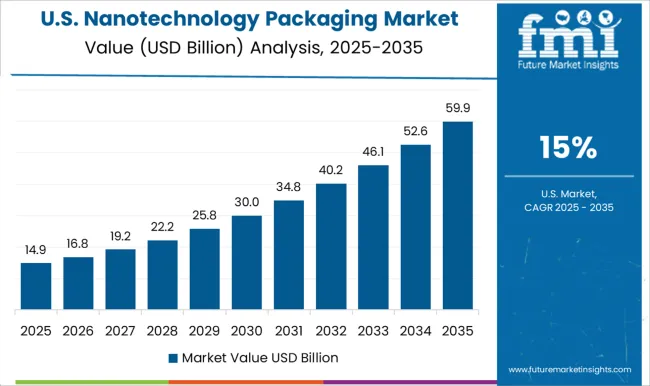
The region is seeing an increase in demand for creative and advanced packaging solutions in a variety of end-use industries, including food & beverage, medicines, and electronics.
North America nanotechnology packaging market was assessed at USD 20.2 billion in 2024, with a CAGR of 12.3% predicted from 2024 to 2029. Regional growth is driven by the factors such as
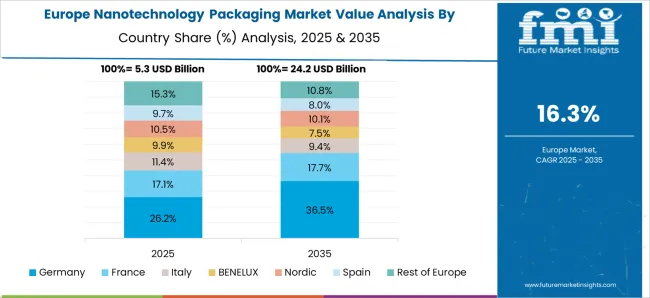
The increasing need for sustainable and eco-friendly packaging solutions and the presence of a large number of package manufacturers in the region are driving growth in this market.
Given the increasing demand for advanced packaging solutions from diverse end-use industries such as food and beverage, pharmaceuticals, and personal care, Germany is Europe's significant customer base for Nanotechnology Packaging.
The country is experiencing a huge transition toward sustainable and environment-friendly packaging solutions, which is increasing demand for nanotechnology-based materials.
The country's market is primarily driven by rising consumer electronics demand and a great emphasis on environment-friendly packaging. Nanotechnology packaging protects items better, has a low environmental effect, and improves product performance, which is pushing its acceptance in India market.
Indian government's attempts to support nanotechnology research & development and encourage international investment in this field are projected to drive market growth even further.
The country has a large presence of nanotechnology research institutes and universities, which is also helping to create India's nanotechnology packaging sector. Overall, India market for nanotechnology packaging is likely to expand dramatically in the future years.
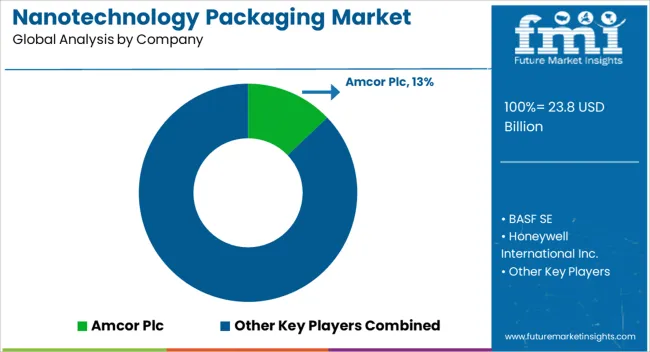
Some of the leading companies in the market include Amcor Limited, 3M Company, Bemis Company, Inc., Chevron Phillips Chemical Company LLC, and Honeywell International Inc. These companies are actively investing in research and development to innovate new products and expand their product portfolios to gain a competitive edge in the market.
The market is also witnessing the emergence of several startups and small and medium-sized enterprises (SMEs) that are leveraging nanotechnology to develop new and innovative packaging solutions. These players are focusing on niche applications and developing cost-effective solutions to gain a foothold in the market.
Companies are also focusing on expanding their presence in emerging markets such as Asia Pacific and Latin America, which offer significant growth opportunities for the nanotechnology packaging market.
Latest Developments
| Attribute | Details |
|---|---|
| Growth Rate | CAGR of 17.6% from 2025 to 2035 |
| Base Year of Estimation | 2025 |
| Historical Data | 2020 to 2025 |
| Forecast Period | 2025 to 2035 |
| Quantitative Units | Revenue in USD million and Volume in Units and F-CAGR from 2025 to 2035 |
| Report Coverage | Revenue Forecast, Volume Forecast, Company Ranking, Competitive Landscape, growth factors, Trends, and Pricing Analysis |
| Key Segments Covered | By Packaging Type, By End User Industry, By Region |
| Regions Covered | North America; Latin America; Europe; East Asia; South Asia; The Middle East & Africa; Oceania |
| Key Countries Profiled | The United States, Canada, Brazil, Mexico, Germany, Italy, France, The United Kingdom, Spain, Russia, China, Japan, India, GCC Countries, Australia |
| Key Companies Profiled | Amcor Limited; 3M Company; Bemis Company, Inc.; Chevron Phillips Chemical Company LLC; and Honeywell International Inc. |
The global nanotechnology packaging market is estimated to be valued at USD 23.8 billion in 2025.
The market size for the nanotechnology packaging market is projected to reach USD 120.4 billion by 2035.
The nanotechnology packaging market is expected to grow at a 17.6% CAGR between 2025 and 2035.
The key product types in nanotechnology packaging market are active packaging, controlled release packaging and intelligent packaging.
In terms of application outlook, food & beverages segment to command 62.5% share in the nanotechnology packaging market in 2025.






Our Research Products

The "Full Research Suite" delivers actionable market intel, deep dives on markets or technologies, so clients act faster, cut risk, and unlock growth.

The Leaderboard benchmarks and ranks top vendors, classifying them as Established Leaders, Leading Challengers, or Disruptors & Challengers.

Locates where complements amplify value and substitutes erode it, forecasting net impact by horizon

We deliver granular, decision-grade intel: market sizing, 5-year forecasts, pricing, adoption, usage, revenue, and operational KPIs—plus competitor tracking, regulation, and value chains—across 60 countries broadly.

Spot the shifts before they hit your P&L. We track inflection points, adoption curves, pricing moves, and ecosystem plays to show where demand is heading, why it is changing, and what to do next across high-growth markets and disruptive tech

Real-time reads of user behavior. We track shifting priorities, perceptions of today’s and next-gen services, and provider experience, then pace how fast tech moves from trial to adoption, blending buyer, consumer, and channel inputs with social signals (#WhySwitch, #UX).

Partner with our analyst team to build a custom report designed around your business priorities. From analysing market trends to assessing competitors or crafting bespoke datasets, we tailor insights to your needs.
Supplier Intelligence
Discovery & Profiling
Capacity & Footprint
Performance & Risk
Compliance & Governance
Commercial Readiness
Who Supplies Whom
Scorecards & Shortlists
Playbooks & Docs
Category Intelligence
Definition & Scope
Demand & Use Cases
Cost Drivers
Market Structure
Supply Chain Map
Trade & Policy
Operating Norms
Deliverables
Buyer Intelligence
Account Basics
Spend & Scope
Procurement Model
Vendor Requirements
Terms & Policies
Entry Strategy
Pain Points & Triggers
Outputs
Pricing Analysis
Benchmarks
Trends
Should-Cost
Indexation
Landed Cost
Commercial Terms
Deliverables
Brand Analysis
Positioning & Value Prop
Share & Presence
Customer Evidence
Go-to-Market
Digital & Reputation
Compliance & Trust
KPIs & Gaps
Outputs
Full Research Suite comprises of:
Market outlook & trends analysis
Interviews & case studies
Strategic recommendations
Vendor profiles & capabilities analysis
5-year forecasts
8 regions and 60+ country-level data splits
Market segment data splits
12 months of continuous data updates
DELIVERED AS:
PDF EXCEL ONLINE
Nanotechnology for food packaging Market
Packaging Supply Market Size and Share Forecast Outlook 2025 to 2035
Packaging Testing Services Market Size and Share Forecast Outlook 2025 to 2035
Packaging Tubes Market Size and Share Forecast Outlook 2025 to 2035
Packaging Jar Market Forecast and Outlook 2025 to 2035
Packaging Barrier Film Market Size and Share Forecast Outlook 2025 to 2035
Packaging Films Market Size and Share Forecast Outlook 2025 to 2035
Packaging Laminate Market Size and Share Forecast Outlook 2025 to 2035
Packaging Burst Strength Test Market Size and Share Forecast Outlook 2025 to 2035
Nanotechnology Photocatalysis Surface Coating Industry Analysis in AMEA Size and Share Forecast Outlook 2025 to 2035
Packaging Tapes Market Analysis - Size, Share, & Forecast Outlook 2025 to 2035
Packaging Materials Market Size and Share Forecast Outlook 2025 to 2035
Packaging Labels Market Size and Share Forecast Outlook 2025 to 2035
Packaging Equipment Market Size and Share Forecast Outlook 2025 to 2035
Packaging Resins Market Size and Share Forecast Outlook 2025 to 2035
Packaging Inspection Systems Market Size and Share Forecast Outlook 2025 to 2035
Packaging Design And Simulation Technology Market Size and Share Forecast Outlook 2025 to 2035
Packaging Suction Cups Market Size and Share Forecast Outlook 2025 to 2035
Packaging Straps and Buckles Market Size and Share Forecast Outlook 2025 to 2035
Packaging Coating Market Analysis - Size, Share, & Forecast Outlook 2025 to 2035

Thank you!
You will receive an email from our Business Development Manager. Please be sure to check your SPAM/JUNK folder too.
Chat With
MaRIA